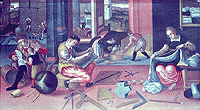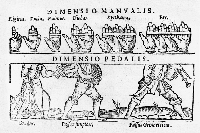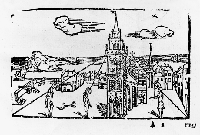
The Measurers:
a Flemish Image of Mathematics in the Sixteenth Century
Introduction
'The Measurers: a Flemish Image of Mathematics in the Sixteenth Century' was a Special Exhibition displayed at the Museum of the History of Science in Oxford during 1995. The exhibition was centered around a very unusual and important painting in the Museum's collection, known simply as 'The Measurers'. The painting depicts a range of practical activities, foremost among them mathematical instrument making, and is used in the context of the exhibition both as a starting point for a discussion of the practical mathematics movement of Renaissance Europe and as a means of organizing the display of a large number of scientific instruments, texts and other related objects.
Organization of the Virtual Exhibition
This virtual version of the exhibition derives from the printed catalogue that accompanied the exhibition and includes over 6000 words of text together with some 150 or so images illustrating a selection of the objects on display. It is organized around three main sections. A preliminary section, 'The Mathematicians', deals briefly with the practical mathematics movement of Renaissance Europe and with the important Flemish contributions to it. 'The Measurers' and 'The Collectors' form the two core sections of the exhibition in terms of the objects represented. 'The Measurers' derives from the account pictorially presented in the painting of the everyday usefulness of mathematics; it is further divided, according to the activity being portrayed, into seven subsections: The Instrument Maker, Music, Weighing, Gauging, Surveying, Measuring Grain, and Measuring Cloth. 'The Collectors', on the other hand, accommodates most of the relevant surviving instruments, although it presents a very different record of sixteenth-century mathematics from the painting itself.
The objects associated with each main section of the exhibition are each described in detail in the Catalogue; hypertext links are provided to the appropriate entries in this catalogue at revelant points in the text.
This introduction, each of the three main sections of the exhibition, and the catalogue are also accompanied by a number of figure illustrations embedded in the text in the form of small images. These images form hypertext links to pages containing a medium-sized version of the same image together with the figure caption. These medium-sized images, in turn, form hypertext links to further, highly enlarged versions of the same illustrations. While these images reveal an extremely fine level detail, the files are large (1-4 MBytes), so beware: they may take some time to download. A consolidated List of Figures provides an alternative route and index to all the illustrations.
The Measurers as a Focus for an Exhibition of Scientific Instruments
The collection of the Museum of the History of Science in Oxford are a rich resource for displaying the
mathematical culture of the Renaissance as it flourished in different parts of Europe. 'The Measurers' focuses on the sixteenth-century Netherlands and has been organized around the famous painting in the collection of the same title. While a former attribution to
Hendrik van Balen has been revised, the painting is by a Flemish artist of the late sixteenth century and represents the usefulness of mathematics to a range of practical activities, including instrument making, surveying, music-making, weighing, gauging and measuring grain and cloth. The assertion of utility is a common theme in mathematical books of the time, but the
iconography of the picture is unusual: paintings more commonly represent mathematics as a higher form
of learning, as a manifestation of affluent connoisseurship, or as a link to the transcendental. The
Measurers illustrates rather its everyday applications, with instruments in use rather than posing in
still life. At the centre of the composition and central to the whole mathematical endeavour is the
instrument maker with a range of his products, while around him we see his instruments applied to a
variety of practical problems.
The Measurers concerns itself deliberately and pointedly with workaday mathematics and the
usefulness of geometry in domestic and working life. Although the Museum collections are especially
strong in mathematical instruments from the period, it has not been possible to fill the showcases of the
exhibition with the instruments included in the picture without straying from the period and the location it
represents. On the other hand, a number of very fine instruments, among the finest in the Museum, are
appropriate in time and place but are not represented in the picture. The reason for this discrepancy is not
difficult to see. Everyday objects are used, worn out in use and discarded for newer or better substitutes.
Because they are familiar, they are not valued and preserved. More exotic, expensive or unusual objects
have a better chance of survival, indeed some of those included in the exhibition have been collectors'
items from their very inception.


Figure 2 Figure 3
Visitors to exhibitions of any kind should be conscious that what they see is circumscribed and directed by the accumulated activities of collectors, both private and institutional. Museum collections
must be approached in a critical frame of mind, with every bit as much concern for the context of
composition as written historical records would be - indeed more so, as collecting strategies change over
time and the shape of today's collections depends on a multitude of successive judgements made in
different contexts.
Next section
Contents
(c) Museum of the History of Science, Broad Street, Oxford, England.


